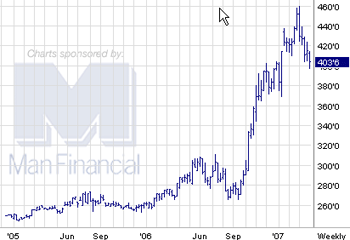One of the side effects of the rapid increase in ethanol consumption in the US is that corn—the main feedstock for ethanol—has gotten much more expensive. Just take a look at the futures markets: the July 2007 corn contract started climbing last fall, which was about the time people started to realize just how quickly demand for corn-based ethanol was growing.
Obviously, rising costs trickle down to consumers in all sorts of ways. If corn prices stay high, meat, poultry, and dairy products will all get more expensive, since the animals are fed lots of corn. But more directly, stuff that’s made from corn—such as the corn flour, corn sweeteners, and corn oils that are used in all sorts of processed foods—will get pricier too. (Sorry, donut fiends.)
So wait, does this mean that there’s an upside to the rapid rise in corn prices? If junk food gets more expensive, will we eat more healthfully?
Not likely.
Even at today’s prices, corn is almost incomprehenisibly cheap. A bushel of corn has more than 130,000 food calories—in theory, enough to sustain a person for over 2 months. And even after the recent increase in corn prices, a bushel of corn still runs only about $4—meaning that a full year’s worth of corn calories costs less than $25.
So the corn in a box of corn flakes or a bag of Doritos costs pennies, really. The bulk of what we pay goes for processing, transportation, marketing, packaging, retailing expenses, and (of course) profits.
My guess is that, if corn prices stay high, most folks will barely notice a change. Of course, food companies might cut back on portion sizes a bit, to help recoup profits—and that might mean we’ll wind up eating a little less junk. But still, the effect on overall consumption is likely to be so small as to be statistically unnoticeable.
On the other hand, for low-income folks—who don’t have a lot of money to spend on food—the runup in corn prices could actually be enough to influence purchasing decisions. But here’s the rub: increases in corn prices could create incentives for low-income folks to buy even morecalorie dense, corn-based foods, not less. Yikes!
Yeah, that’s counterintuitive. When the price of something goes up, people are supposed to buy less of it, right? Not necessarily. Economists have identified a class of goods (called Giffen goods) that do just the opposite—as their price rises, so does consumption.
Here’s why. Let’s say that you’re on a limited income that forces you to buy as cheaply as possible, and budget your food purchases down to the penny. If corn-based foods (including meat & dairy products) get more expensive, but fruits and veggies don’t get any cheaper, your budget gets squeezed: you’ve got to cut back on something. Your only option is to cut back on the foods that cost the most per calorie—namely, fruits and veggies—and make up the difference by buying cheaper calories—which, despite the price increase, are still corn products.
The end result: you buy less fruits and veggies and more corn, and your diet goes from bad to worse.
Now, I’m not sure that’s actually going to happen—the Giffen good phenomenon is pretty unusual.
Still, my bet is that that the runup in corn prices we’ve seen so far won’t do much of anything to curb the typical consumer’s appetite for junk food; but could undermine the diets (and, of course, budgets) of lower-income folks. So from a dietary standpoint, there’s not much of a silver lining to the rise in corn prices.








